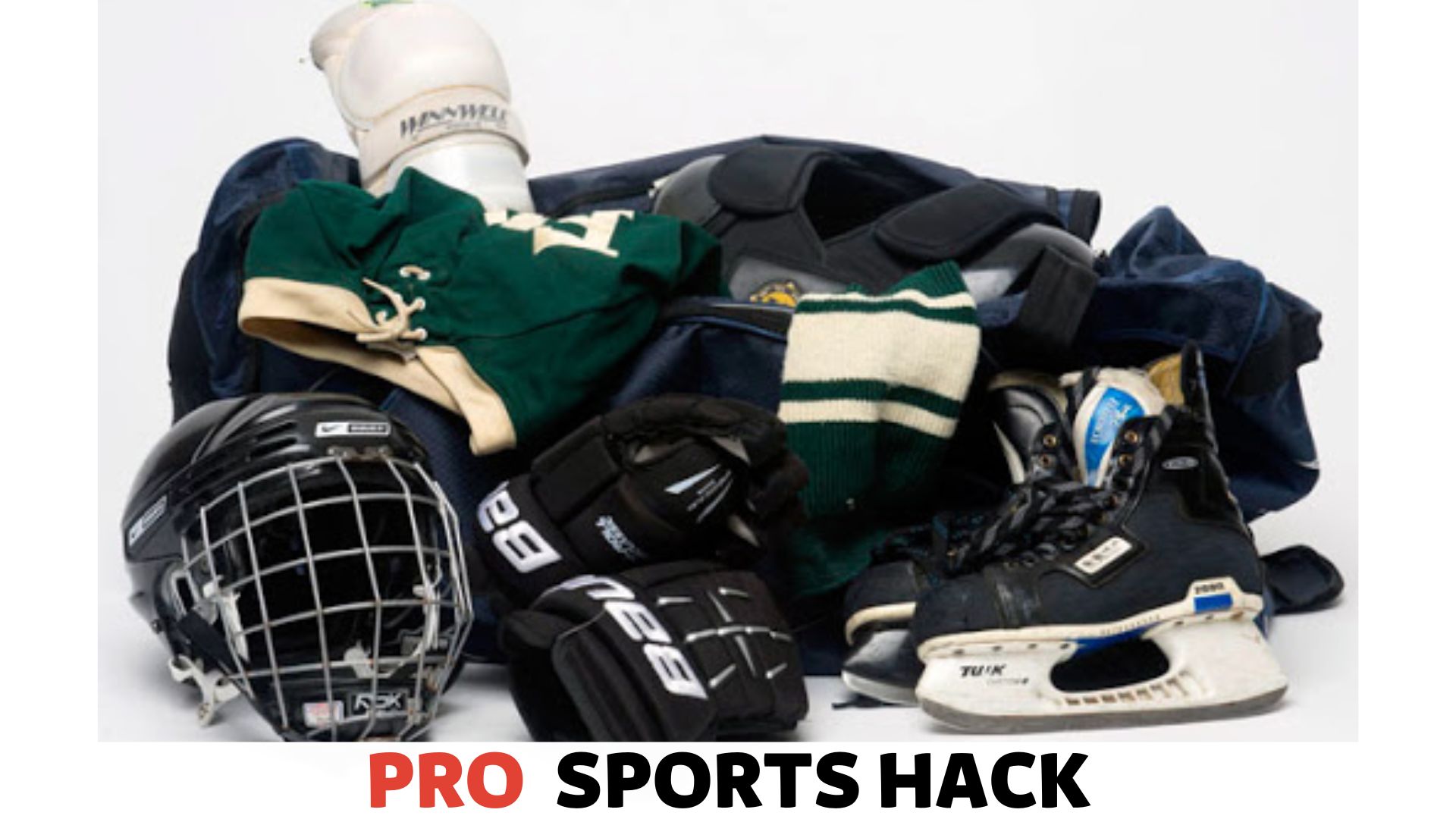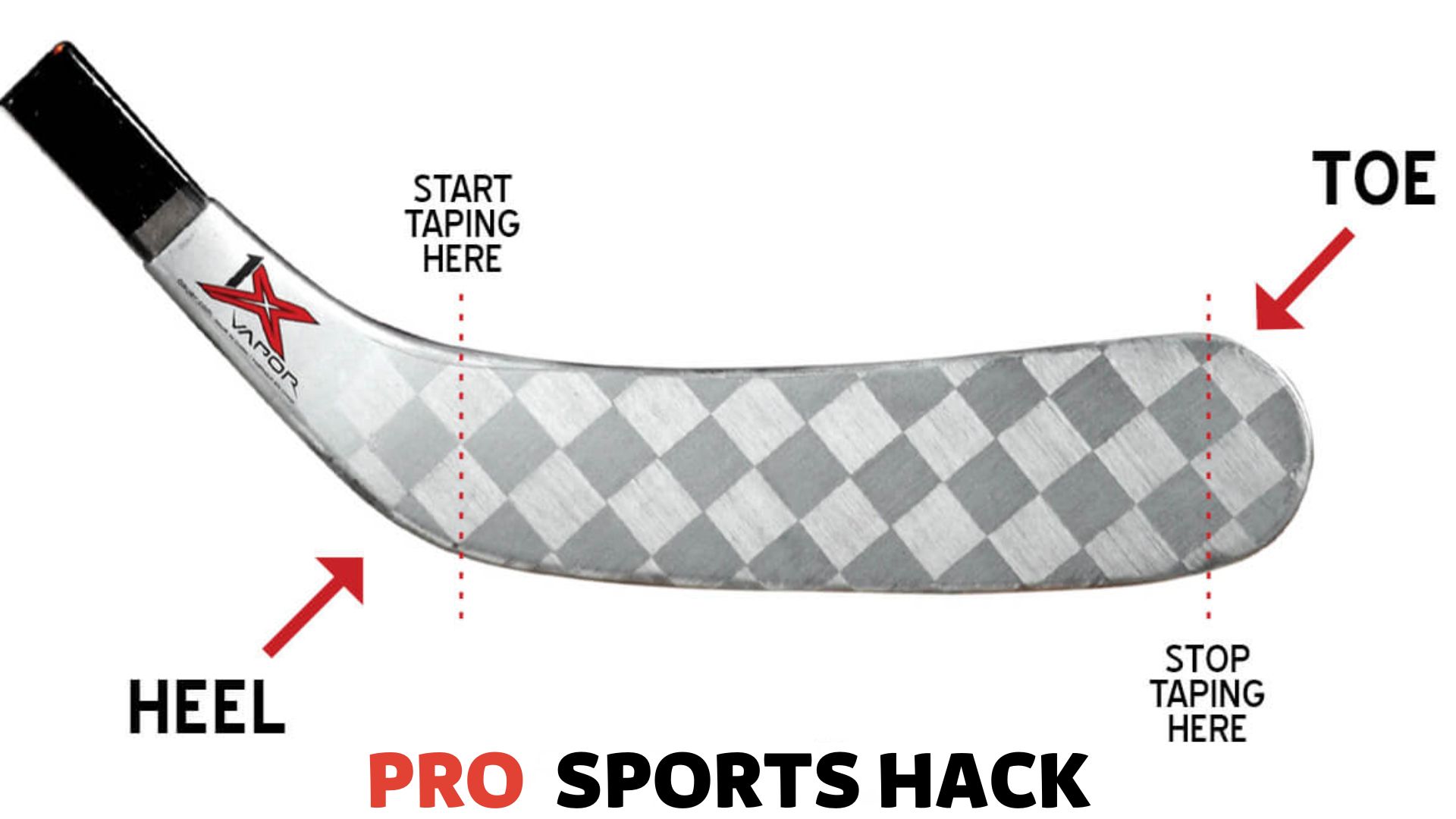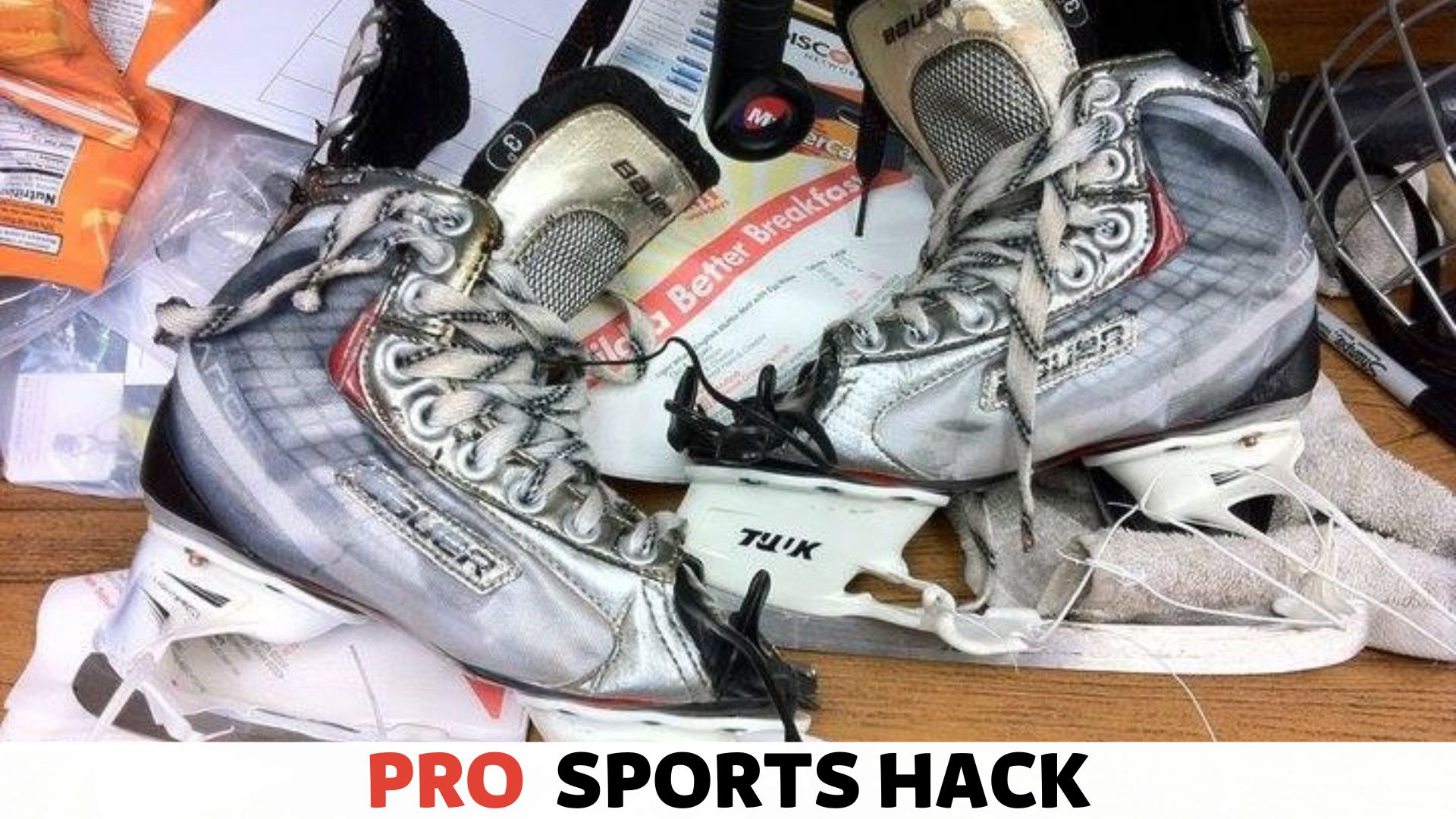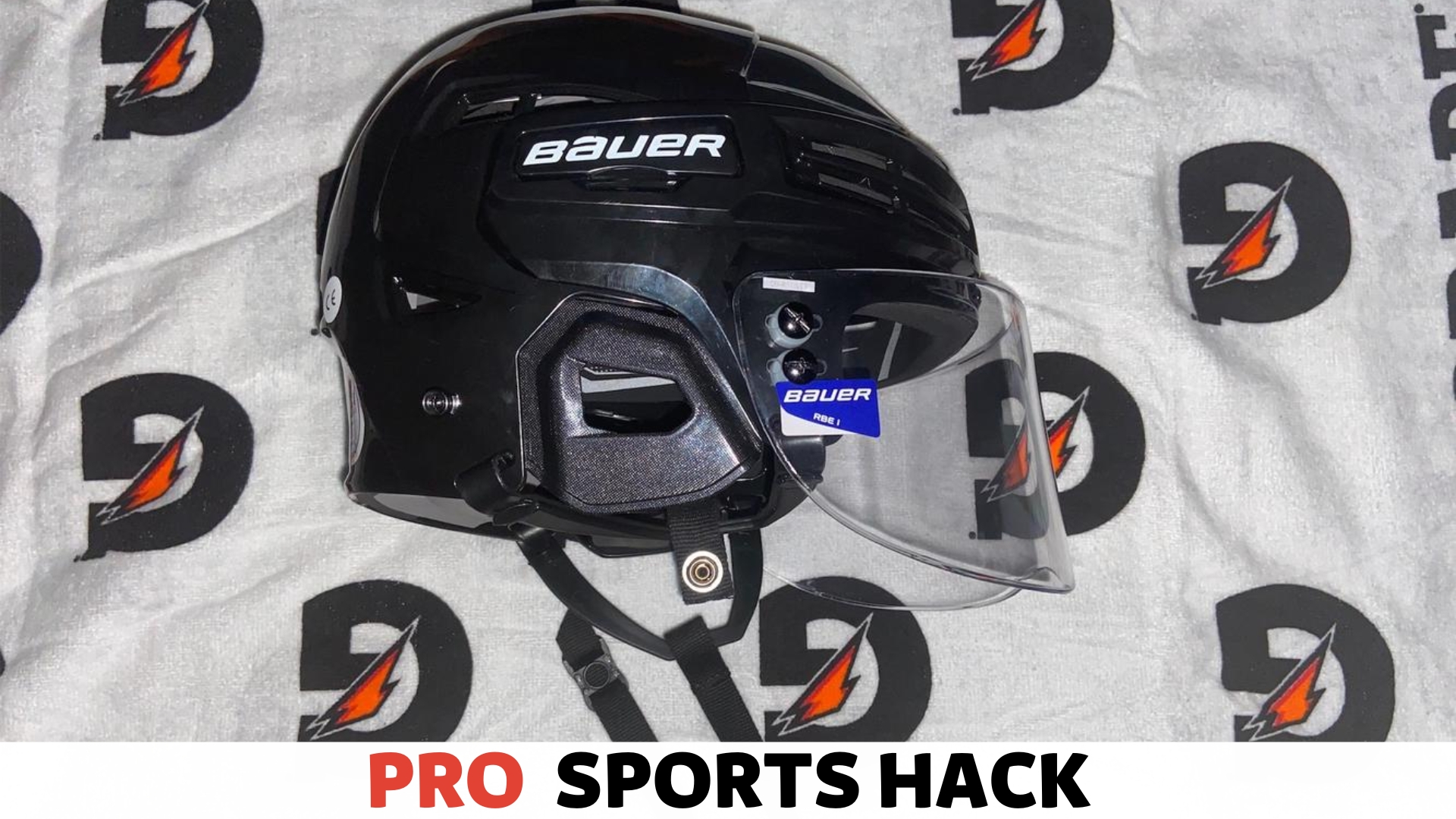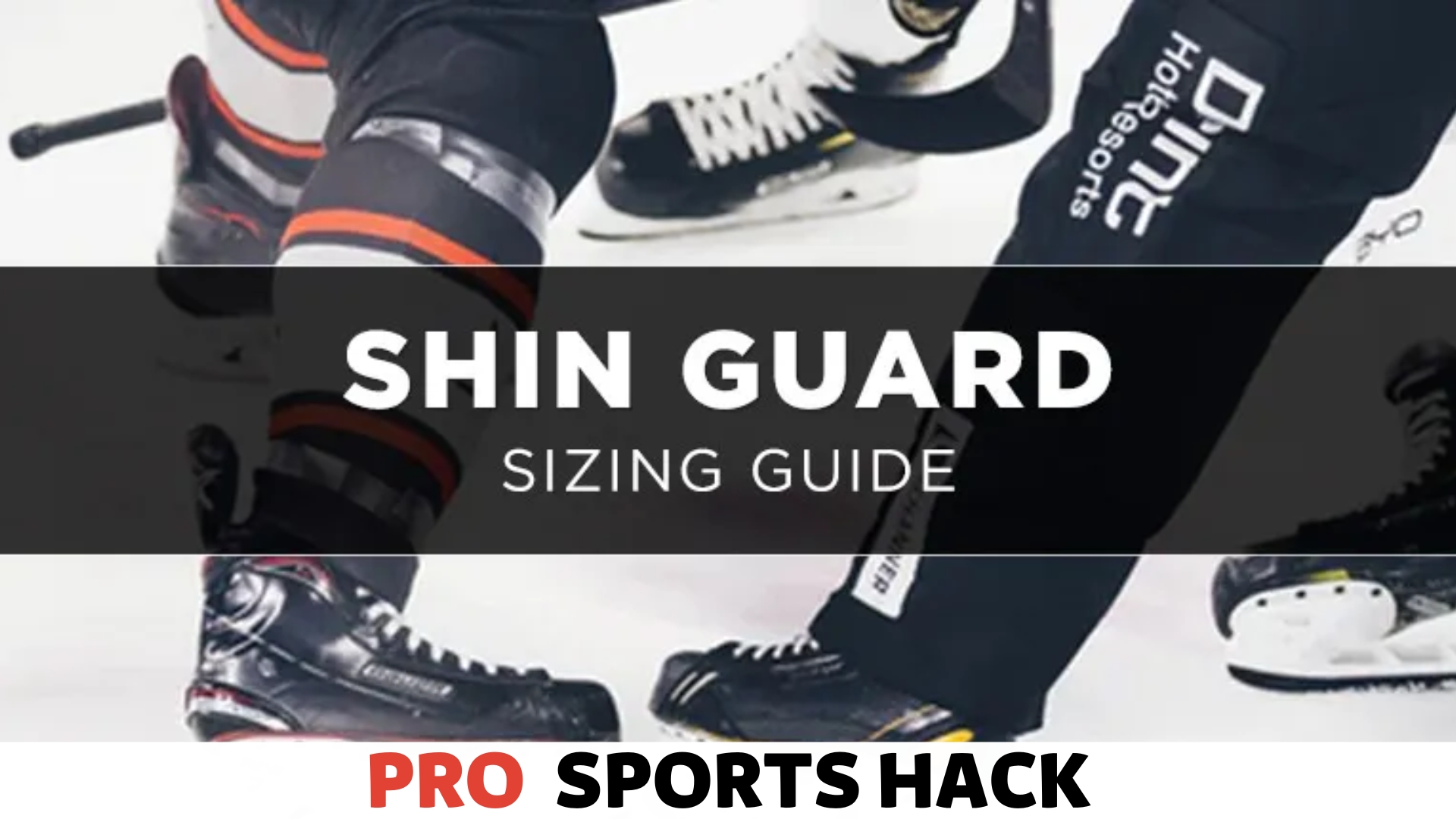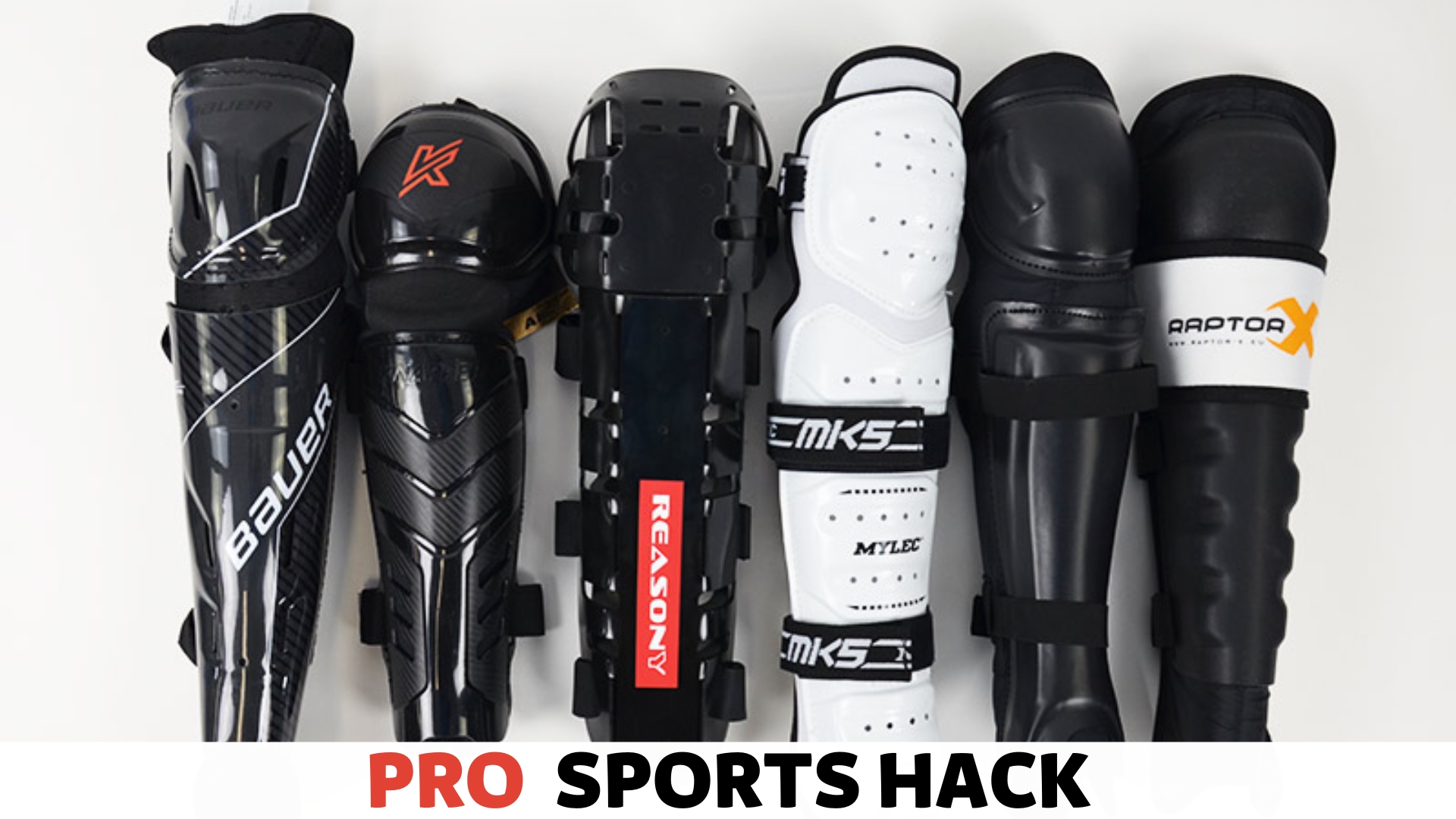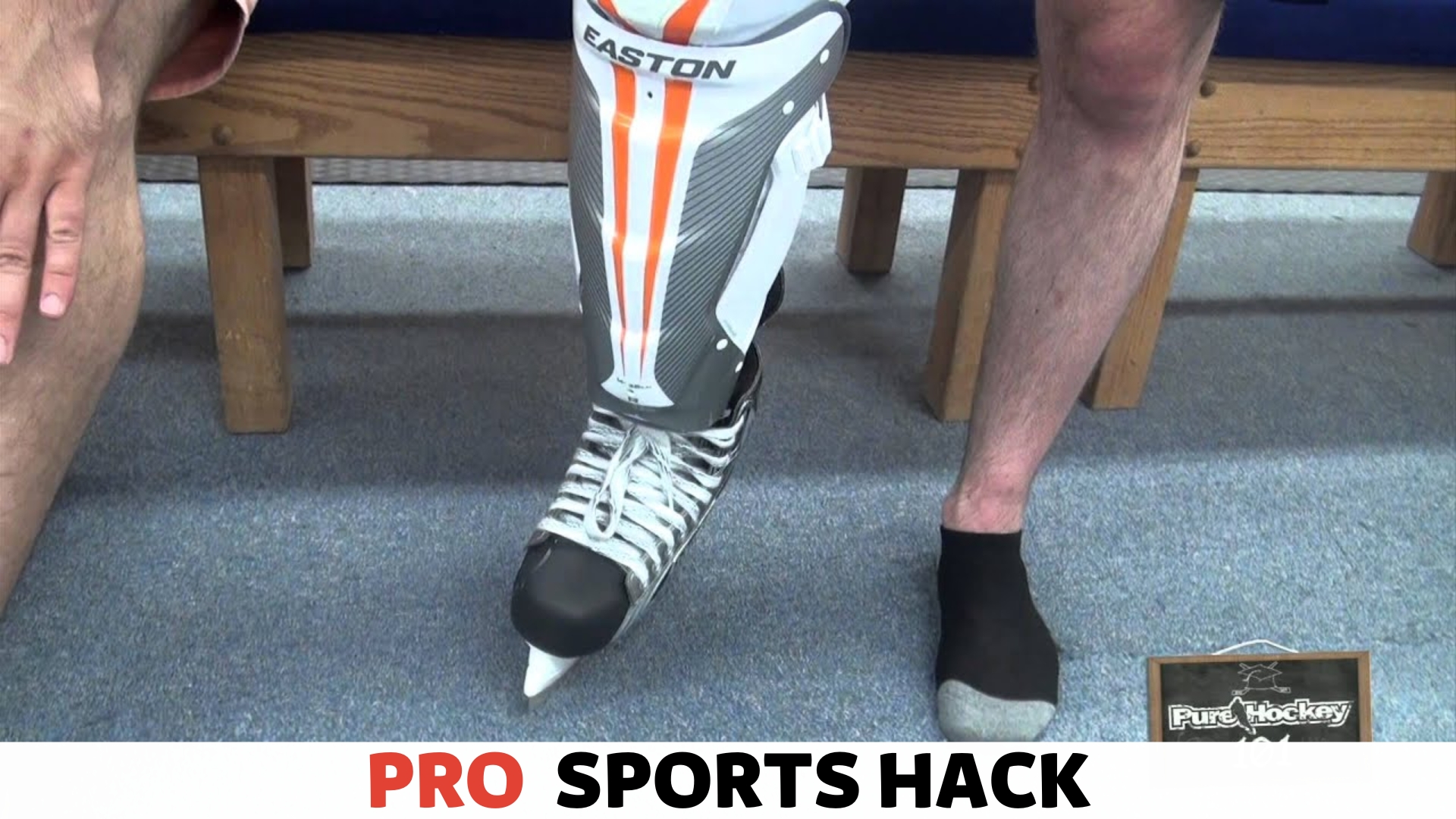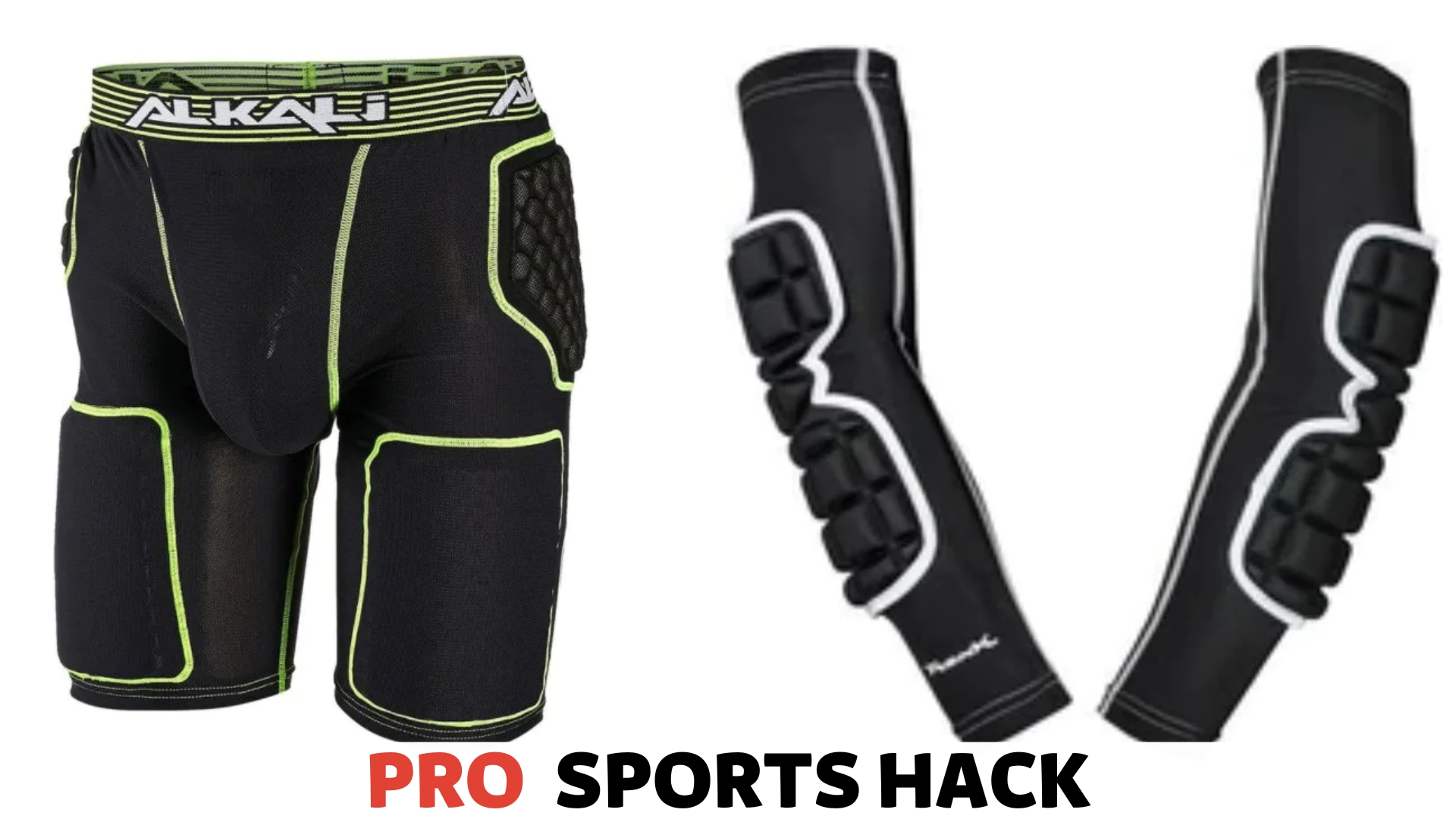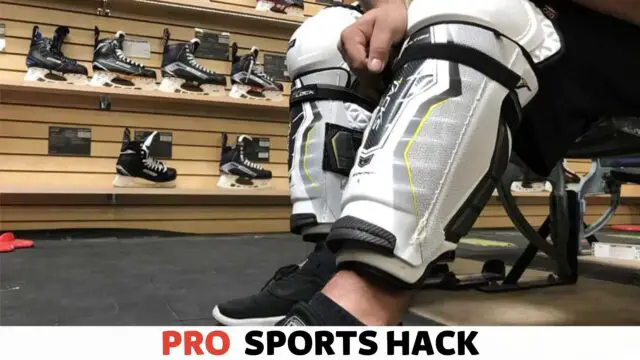
To fit hockey shin pads, follow these steps: First, place the shin pad over your shin, ensuring it covers from just below the knee to the top of your skate. Then, fasten the straps securely around your leg, ensuring the pad is snug and doesn’t move during play.
Hockey shin pads are crucial equipment that protects the lower leg from impacts and slashes. Properly fitting shin pads ensure maximum safety and offer comfort and flexibility on the ice.
This guide will walk you through accurately fitting your hockey shin pads.
Following these instructions ensures that your shin pads offer optimal protection and mobility, allowing you to perform best during games and practices.
So, let’s dive into fitting your hockey shin pads for a safe and comfortable playing experience.
The Importance of Properly Fitting Shin Pads
Why Having the Right Size is Crucial for Protection?
Properly fitting shin pads are essential for any hockey player, regardless of skill level. When protecting your legs from injuries, having the right size shin pads is crucial.
Ill-fitting pads may expose areas, leaving you vulnerable to painful hits and potential fractures. To ensure maximum protection, knowing your correct shin pad size is important.
The Impact of Ill-fitting Shin Pads on Performance and Comfort
Not only do properly fitting shin pads provide vital protection, but they also play a significant role in your overall performance and comfort on the ice. Ill-fitting pads can affect your mobility, hindering your agility and speed.
They can also cause discomfort, leading to distractions and reduced focus during the game. It’s essential to prioritize your performance and comfort by wearing perfectly fitting shin pads.
How to Ensure a Secure Fit That Doesn’t Hinder Movement
- Measure your leg: Start by measuring your leg length from the top of your foot to just below your knee. Use a measuring tape or ruler to get an accurate measurement.
- Refer to size charts: Each brand may have slightly different size measurements, so it’s important to check their size guide carefully before purchasing. Compare your leg measurement with the brand’s recommended shin pad size to ensure a proper fit.
- Try them on: Once you have ordered or purchased your shin pads, try them on to ensure they fit correctly. They should cover your entire shin, from just below the knee to the top of your skates. Ensure the pad is snug but not too tight, allowing free movement without discomfort.
- Secure with straps: Most shin pads have adjustable straps or Velcro closures. Secure the straps tightly around your calf to prevent them from shifting during the game while maintaining a comfortable fit.
By following these steps, you can ensure a secure fit that doesn’t hinder your movement on the ice. Remember, properly fitting shin pads protect and enhance your performance, allowing you to play your best game.
In our guide on properly gearing up for the game, we explore the essential question: How should hockey shin guards fit to ensure optimal protection and comfort on the ice?
Measuring for the Correct Size
Properly fitting hockey shin pads ensure the player’s safety and performance on the ice. There are a few key measurements to consider to find the ideal size, including understanding the different measurement points, determining the length from the knee to the ankle, and considering the player’s height and weight.
Understanding the Different Measurement Points
When measuring the correct size of hockey shin pads, it’s important to be familiar with the different measurement points. The two main areas to focus on are the knee joint and the ankle bone.
These points will determine the overall length of the shin pads and ensure that they fit securely and provide adequate protection.
Determining the Length From the Knee to the Ankle
To accurately determine the length from the knee to the ankle, follow these simple steps:
- Start by measuring from the center of the kneecap down to the top of the ankle bone.
- Ensure that the player is standing with their knees slightly bent, as this will mimic the position they will be in while playing.
- Use a flexible measuring tape or string to measure the distance, ensuring it is straight along the leg.
By measuring from the knee to the ankle, you can select shin pads that provide adequate coverage while avoiding unnecessary bulkiness or interference with skating movements.
Taking Into Account the Player’s Height and Weight
In addition to measuring the length from the knee to the ankle, it’s important to consider the player’s height and weight when selecting the right size of shin pads. These factors can affect the overall fit and comfort of the pads.
Taller or heavier players may require longer or larger shin pads to protect their legs adequately. On the other hand, smaller players may find that shorter or smaller shin pads are a better fit.
It’s worth noting that manufacturers may have slightly different sizing guidelines, so it’s always a good idea to refer to their specific size charts for the most accurate fit.
By understanding the different measurement points, determining the length from the knee to the ankle, and considering the player’s height and weight, you can ensure that your hockey shin pads fit properly and provide the necessary protection for an enjoyable and safe game on the ice.
Choosing the Right Style
When it comes to fitting hockey shin pads, choosing the right style is crucial for comfort, protection, and performance on the ice.
The style of shin pads you choose will depend on various factors, such as your level of play, position, and personal preferences.
In this section, we will explore different styles of hockey shin pads and help you make an informed decision. Let’s dive in!
Exploring Different Styles of Hockey Shin Pads
When exploring different styles of hockey shin pads, it’s essential to consider the design and construction that best suits your needs.
There are two primary styles to consider: traditional and anatomical designs.
| Traditional Design | Anatomical Design |
|---|---|
| The traditional design offers a classic construction with a straight shin guard and a padded knee cap for maximum protection. | The anatomical design, on the other hand, is contoured to the natural shape of your leg, providing a more customized and snug fit. |
| It delivers excellent coverage and is suitable for players who prioritize maximum protection, such as defensemen or beginners. | The anatomical design is popular among forwards and experienced players who value mobility and a lightweight feel. |
| Traditional shin pads often feature adjustable straps that allow you to secure the pads firmly in place. | Anatomical shin pads come with advanced strapping systems, such as Velcro or elastic bands, ensuring a secure and comfortable fit. |
Considering the Level of Play and Position
Another vital aspect to consider when choosing the right style of shin pads is your level of play and position on the ice.
Different positions require varying levels of mobility, protection, and agility. Here’s a breakdown that can help you make an informed decision:
- Defensemen: Defensemen are often involved in physical play and shot-blocking, so they typically require shin pads with maximum coverage and protection. Traditional shin pads with a larger surface area are commonly preferred in this position.
- Forwards: Forwards, on the other hand, emphasize speed and agility. Anatomical shin pads provide a more lightweight and contoured fit, allowing forwards to move swiftly and make quick plays.
- Beginners: Beginners still learning the game may benefit from the added protection and coverage offered by traditional shin pads. These pads provide security on the ice during the learning process.
- Experienced Players: Experienced players often have well-defined preferences based on their playing style and personal comfort. Anatomical shin pads give them the flexibility and freedom of movement they desire without compromising protection.
By considering your level of play and position, you can choose the style of shin pads that suits your needs, allowing you to perform at your best on the ice.
Fitting the Shin Pads Properly
Properly fitting shin pads are essential for hockey players as they protect the lower legs. When it comes to fitting your shin pads correctly, there are a few important factors to consider.
In this section, we will discuss how to ensure proper placement on the leg, evaluate the coverage of the shin and calf, and secure the pads effectively with straps or laces.
Ensuring Proper Placement on the Leg
When fitting shin pads, it is important to ensure they are placed correctly on the leg. Improper placement can lead to discomfort and compromise the effectiveness of the pads. To ensure proper placement:
- Place the shin pad on the front of your leg.
- Position it just below the kneecap.
- Ensure the shin pad covers the entire shin from just above the ankle to below the knee.
- Ensure the pad is centered on your leg, with equal coverage on both sides.
By following these steps, you can ensure that your shin pad fits securely and provides optimal protection.
Evaluating the Coverage of the Shin and Calf
In addition to proper placement, evaluating the coverage of the shin and calf is crucial. Shin pads should provide adequate protection to these areas, as they are prone to injuries during the game. To evaluate the coverage:
- Check if the shin pad covers the entire front of your shin adequately.
- Ensure the coverage extends beyond the sides of the shin bone for added protection.
- Check if the shin pad extends to cover a portion of your calf muscle.
- Evaluate the shin pad’s length to ensure it does not hinder your movement.
By evaluating the coverage of your shin pads, you can ensure that your legs are well-protected without impeding your performance on the ice.
Securing the Pads With Straps or Laces
Securing them effectively is crucial once you have properly positioned the shin pads and evaluated the coverage. This prevents the pads from shifting during gameplay and ensures consistent protection. There are two common methods to secure shin pads:
- Using straps: Most shin pads have adjustable straps that wrap around your leg and hold the pads in place. Make sure to tighten the straps firmly, but not too tight that they cause discomfort or restrict circulation.
- Using laces: Some players prefer laces to secure their shin pads. Lacing the pads through the designated holes provides a secure fit. Ensure the laces are tight enough so the shin pad stays in place, allowing for comfortable movement.
Whichever method you choose, it is important to regularly check the tightness of the straps or laces throughout the game to maintain optimal protection.
By following these steps and ensuring proper placement, evaluating coverage, and securing the shin pads effectively, you can have confidence in your protective gear and focus on your performance on the ice.
Delve into the nuances of field hockey safety with our comprehensive guide, covering everything from stick handling to proper equipment sizing, including a detailed exploration of field hockey shin guards sizing.
Checking for Proper Fit And Comfort
When it comes to fitting hockey shin pads, checking for proper fit and comfort is essential. The shin pads protect the player’s legs from injuries and provide a comfortable and unrestricted range of motion.
In this section, we will discuss how to check for proper fit and comfort by testing the range of motion, assessing pad stability and flexibility, and ensuring a comfortable fit without restricting movement.
Testing the Range of Motion
The range of motion is crucial for players to maneuver on the ice effectively. To test the range of motion with your shin pads, follow these steps:
- Put on both shin pads and make sure they are properly secured.
- Bend your knees and squat down to mimic the skating position.
- Try performing various hockey movements, such as forward and backward strides, crossovers, and quick turns.
- Pay attention to any restrictions or discomfort. The shin pads should allow you to move freely without hindrance.
Assessing Pad Stability and Flexibility
Pad stability and flexibility are essential for absorbing impacts while providing optimal protection. Here’s how you can assess these factors:
- Stand up straight and shift your weight from one leg to another.
- Ensure the shin pads stay securely in place and do not shift around during these weight transfers.
- Bend your knees and flex your legs to check if the shin pads maintain stability and support.
- Flex your calf muscles and see if the pads contour well to your legs without restricting movement.
Ensuring a Comfortable Fit Without Restricting Movement
Comfort is paramount when it comes to shin pad fit. Follow these steps to ensure a comfortable fit without restricting movement:
- Start by properly measuring your leg size to choose the correct shin pad size.
- Adjust the straps or closures to achieve a snug fit without cutting off circulation or causing discomfort.
- Check that the shin pads cover the entire lower leg, from just above the ankle to below the knee.
- Ensure that the shin pads do not impede your ability to flex your knee or extend your leg.
- If possible, try skating or practicing hockey movements with the shin pads on to ensure they remain comfortable and allow for a full range of motion.
By testing the range of motion, assessing pad stability and flexibility, and ensuring a comfortable fit without restricting movement, you can find the perfect fit for your hockey shin pads.
Remember, a properly fitted and comfortable pair of shin pads will enhance your performance on the ice while keeping you protected.
Adjusting and Fine-Tuning The Fit
When it comes to fitting hockey shin pads, adjusting and fine-tuning the fit is essential to ensure optimal comfort and protection on the ice.
In this section, we will explore the steps to make necessary adjustments for personalized comfort, test mobility and range of motion after adjustments, and troubleshoot common fit issues.
By following these tips, you can ensure that your shin pads are securely in place and allow for optimal performance during the game.
1. Making Necessary Adjustments for Personalized Comfort
Adjusting your shin pads to fit your unique leg shape and size is crucial for a comfortable fit. Here are the steps to follow:
- Start by fastening the straps snugly around your calf, ensuring they are secure but not too tight that they restrict blood flow.
- Adjust the length of the shin pad so that it covers the entire length of your shin, from just above the ankle bone to just below the knee.
- Position the kneecap of the shin pad in the center of your knee joint to provide adequate protection.
- Ensure the shin pad fits closely to your leg without gaps or loose areas.
By customizing the fit of your shin pads, you can minimize discomfort and ensure the best possible protection for your legs.
2. Testing Mobility and Range of Motion After Adjustments
Once you have made the necessary adjustments, testing your mobility and range of motion is important to ensure that the shin pads do not restrict your movement on the ice. Here’s how:
- Bend your knees and perform various skating movements, such as forward strides, crossovers, and quick turns.
- Check if the shin pads stay securely in place without shifting or sliding during these movements.
- Ensure that your ankles have enough flexibility and freedom of movement without excessive pressure from the shin pads.
Testing your mobility and range of motion will help determine if further adjustments are needed to achieve a perfect fit.
3. Troubleshooting Common Fit Issues and Finding Solutions
You might encounter common fit issues with your shin pads despite careful adjustments. Here are some troubleshooting tips:
| Fit Issue | Solution |
|---|---|
| Loosen the straps slightly, or consider purchasing shin pads in a larger size to enhance comfort and mobility. | Reposition the shin pad and adjust the straps to ensure the knee cap is centered on your knee. |
| The shin pads restrict movement and feel too tight | Try using additional Velcro straps or hockey tape to secure the shin pads. |
| The knee cap does not align properly with your knee joint | Reposition the shin pad and adjust the straps to ensure that the knee cap is centered on your knee. |
By troubleshooting these common fit issues, you can address any discomfort or hindrance to your performance, allowing you to focus on the game.
With these tips for adjusting and fine-tuning the fit of your hockey shin pads, you can ensure maximum comfort, mobility, and protection during your time on the ice.
Remember to regularly check the fit of your shin pads and make any necessary adjustments to maintain optimal performance.
Maintaining and Caring for Shin Pads
Proper maintenance and care of your hockey shin pads are essential for their longevity, hygiene, and safety.
In this section, we will discuss the different steps you can take to clean and disinfect your shin pads, check for wear and tear, and know when it’s time to replace them.
Additionally, we will explore proper storage techniques that can help you maximize the lifespan of your shin pads.
By following these simple guidelines, you can ensure that your shin pads remain in top condition for years, allowing you to focus on your game without any worries.
Cleaning and Disinfecting to Prevent Odor and Bacteria Buildup
Over time, your hockey shin pads can accumulate sweat, dirt, and bacteria, leading to unpleasant odors and potential health issues. It is crucial to clean and disinfect your shin pads regularly to maintain their freshness and hygiene.
Follow these steps to clean your shin pads effectively:
- Start by removing any removable inserts or padding from the shin pads.
- Fill a basin with lukewarm water and add a mild detergent specifically designed for sports gear.
- Gently scrub the shin pads using a soft-bristle brush or cloth to remove dirt or grime.
- Rinse the shin pads thoroughly with clean water to remove any soapy residue.
- Disinfect the shin pads by spraying them with an antibacterial solution or wiping them down with disinfectant wipes. Pay extra attention to the areas that come into direct contact with your skin.
- Air-dry the shin pads completely before reinserting any removable inserts or padding.
Regularly following these cleaning steps can prevent odor buildup and ensure your shin pads remain fresh and bacteria-free throughout the hockey season.
Checking for Wear and Tear and When to Replace Pads
Regularly inspecting your shin pads is vital to ensure they provide optimal protection. Check for any signs of wear and tear, such as:
- Cracks or splits in the hard outer shell.
- Loose or detached straps.
- Worn-out or compressed padding.
If you notice any of these signs, it’s time to replace your shin pads. Using damaged shin pads can compromise your safety and increase the risk of injuries.
Therefore, make it a habit to inspect your shin pads before each game or practice session, and if you spot any damage, replace them promptly to maintain proper protection.
Proper Storage to Maintain Longevity
Proper storage is essential for preserving the longevity of your shin pads. Follow these tips to store your shin pads correctly:
- After each use, wipe down the shin pads with a clean cloth to remove moisture or sweat.
- Allow the shin pads to air dry completely before storing them.
- Avoid storing the shin pads in a damp or humid environment, as this can promote bacteria growth and deterioration of the materials.
- Consider using a mesh bag or specialized sports gear storage container to keep the shin pads properly ventilated and protected from potential damage.
By implementing these storage practices, you can prolong the lifespan of your shin pads and ensure that they remain in optimal condition for future use.
Safety on the ice goes beyond just shin guards. Learn about the often overlooked but crucial aspect of helmet gear as we discuss why you need ear guards on a hockey helmet for enhanced protection and prevention of potential injuries.
Ensuring Safety and Performance
How Properly Fitting Shin Pads Can Enhance Safety on the Ice
Hockey is an exhilarating sport that requires players to be quick on their feet and ready to face the game’s physical demands. The shin pad is one essential piece of protective gear that ensures safety and performance on the ice.
How shin pads fit can greatly impact a player’s ability to stay safe and perform at their best.
Here, we’ll delve into the importance of properly fitting shin pads and how they can enhance safety on the ice.
The Impact of a Secure and Comfortable Fit on Performance
The key to fitting shin pads is to find a balance between security and comfort. Shin pads that are too loose can shift during gameplay, leaving vulnerable areas exposed to potential injuries.
On the other hand, shin pads that are too tight can restrict movement and hinder a player’s performance on the ice.
A secure and comfortable fit ensures optimal performance and confidence during gameplay.
To enhance safety and performance, here are a few important factors to consider when fitting shin pads:
The Importance of Regular Fittings to Meet Changing Needs
As players progress and progress in their hockey journey, their needs and preferences change, too. This is why regular fittings are essential to accommodate these evolving needs.
Growing players may require shin pads with additional length and coverage to ensure proper protection. Similarly, experienced players may prefer a specific style or fit to enhance their performance.
By regularly reassessing and updating shin pad fittings, players can stay ahead of their changing needs and maximize safety and performance.
Remember, finding the right fit is not a one-time task but an ongoing process that ensures players can confidently step onto the ice, knowing their shin pads will provide the utmost protection.
Frequently Asked Questions
How Should Shin Pads Fit For Hockey?
Shin pads for hockey should fit snugly and cover the entire shin from just below the knee to the top of the skate. Ensure they are secure with straps and provide good protection to avoid injuries during play.
How Do I Know If My Shin Pads Fit?
To ensure the proper fit of your shin pads, follow these steps. Firstly, wear a pair of socks to provide a realistic fit. Then, position the shin pad on the front of your leg, covering the shin bone. Ensure that the pad wraps around your leg snugly without restricting movement.
Finally, test the fit by performing movements like running and jumping.
Where Should Your Hockey Shin Pads Go Down To?
Hockey shin pads should cover the entire shin bone and extend to just above the top of the skate. They should provide full protection for the lower leg during games and practices.
What Size Shin Guards for a 9-Year-Old?
A size XS or small shin guard is suitable for a 9-year-old. Measure the distance from the ankle’s top to the knee’s bottom to find the right size.
How to Measure for Hockey Shin Pads?
Place a tape measure from the middle of your kneecap to the top of your skate to measure for hockey shin pads.
Conclusion
To sum up, properly fitting hockey shin pads is crucial for ensuring your safety on the ice. Following the step-by-step guide in this blog post, you can easily find the right size and adjust the straps to achieve a comfortable fit.
Remember, a well-fitted shin pad will protect without restricting movement.
So, ensure you take the time to get it right and enjoy a safe and enjoyable hockey game.




![Cat in the Chrysalis Spoiler: All You Need To Know [Updated] Cat in the Chrysalis Spoiler](https://prosportshack.com/wp-content/uploads/2024/02/Cat-in-the-Chrysalis-Spoiler-100x75.jpg)







